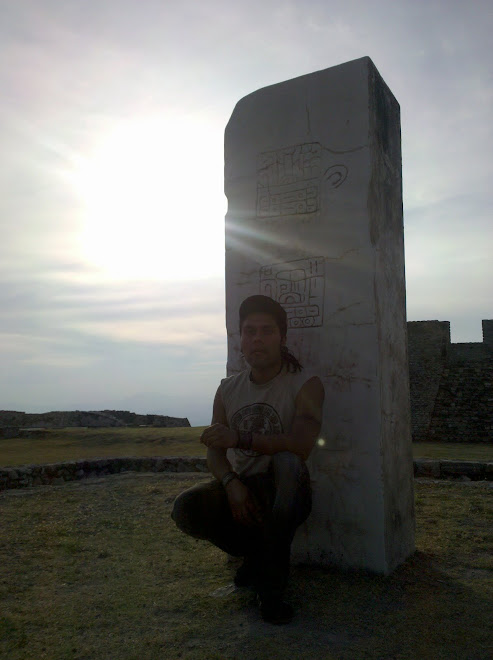


The Hill of Tetzcotzinco is an important Aztec site that is surrounded by agricultural terraces and is located east of Tetzcoco at the base of the Mt. Tlaloc foothills. It is associated with life giving rain rites and agriculture. Although there has been little archaeological excavation at this site, survey plans, surface explorations, and aerial views demonstrate its layout. The architecture of this site combines landscape, sculpture and ritual. Tetzcotzinco is a reenactment of the symbolic landscape of Mt. Tlaloc and has been a place of worship since the time of the Chichimecs . After the famine of 1454 C.E., the tlatoani of Tetzcoco, Netzahuacoyotl, decided to build a new ceremonial center, refurbish, and reconstruct the Hill of Tetzcotzinco. This became the site where Netzahuacoyotl erected his personal palaces. It had rock-cut baths known popularly as the “baths of Nezahualcoyotl” and canals, aqueducts, gardens, and over 300 rooms. Tetzcotzinco had a system of farming terraces extending northward from the hill, forming a huge natural amphitheater, and the hill and the neighboring towns that still exist today, were supplied with water by aqueducts from springs high on Mt. Tlaloc. The hydraulic works of Tetzcotzinco are considered one of the major engineering accomplishments of the Pre-Columbian times . The aqueduct transported water over a distance of eight kilometers from springs at the slopes of Mt. Tlaloc through the Metecatl Hill to irrigate an extensive area of gardens, fountains, and baths carved in the rock of the Tetzcotzinco hill under the auspices of the great poet, engineer, and king Netzahuacoyotl.
Most of the monuments of Tetzcotzinco were destroyed by the Spanish in 1539 C.E.; however, many pictorial manuscripts, texts, and related sculpture and architecture provide useful information to reconstruct what remains of the site. The archaeologist Richard Townsend mapped the area in 1979 and revealed that the upper hill was cosmologically designed. Approximately 55 meters below the summit, the ritual zone is demarcated by a walkway cut around the hill. On this path there are four baths or shallow basins oriented to the four cardinal directions. Their receptacles were manifestations of Chalchiuhtlicue’s aquatic domain and were used for ritual purification. Their water was supplied by an aqueduct built in a circular path that served processional circumambulation and divided the upper sacred zone from the profane space below .
Civic Monuments
Among the civil architectural features that can still be seen at Tetzcotzinco are: the Reservoir System H and the Fountain , a group of water deposits built on the northern skirts of Metecatl Hill with the intention to control the speed and flow of the water that descended to Tetzcotzinco; the Monolithic Room, a pool at the entrance of the hydraulic system that had a temple on top dedicated either to the wind god Ehecatl or to the Sun (Tonatiuh) the aqueduct subsystem circuit with a series of channels every 50 meters to irrigate the gardens, the farming terraces and give services to the royal compounds the so-called King’s and Queen’s baths , a collection of rock-cut monolithic deposits of water with a magnificent view to the former gardens in the slopes of the hill and the Valley of Mexico; and finally, the Palace attributed to Netzahuacoyotl that is not yet excavated.
Shrines
The Tetzcotzinco Hill has a sequence of shrine stations along an east-west axis that follows the natural ridge of the hill. The alignment indicates the path of the sun, leading scholars to believe that Tetzcotzinco had calendrical and astronomical functions determined by the solstice and equinox . In Tetzcotzinco’s summit there are remains of a temple built over a cave . There is also a goggle-eyed mask of
Tlaloc engraved on a bedrock boulder
There is an important shrine that is a cave below the circumscribing path next to the King’s bath and near a system of lower terraces where Netzahualcoyotl’s palace and botanical gardens stood . Caves are associated with the heart of the earth, mountains, and wombs related to fertility. The cave above is related to the ancestors and lineage of Netzahuacoyotl, recalling the genesis theme that people first emerged from the womb of the earth through caves (Chicomoztoc). By placing his compounds next to the cave, Netzahuacoyotl legitimized himself and his legacy.
Another shrine is located high on the western axis, it has two very damaged carved effigies on the living rock; they are of female divinities connected to the cycle of maize. The divinities are associated with the festivals of Huey Tozoztli, Huey Tecuihuitl and Ochpaniztli. Huey Tozoztli was dedicated to Chicomecoatl, the goddess of dried seed corn, and Cinteotl, the conflated male and female deity of the young corn, and was celebrated at the height of the dry season when corn was consecrated for the coming planting. Huey Tecuihuitl was dedicated to Xilonen, goddess of the mature corn, and it occurred during the middle of the rain season. Ochpaniztli was dedicated to the male and female earth and maize deities, and it was celebrated during the harvest to mark the start of the dry season.
The last shrines are Netzalhualcoyotl’s personal commemorative monuments located on the eastern slope of the hill below the summit. There was an ample assembly plaza that was constructed facing an exposed rock-face where the sculptures were carved. The monuments have been destroyed, but from the writings of chronicler Fernando de Alva Ixtlixochitl, it is known that the first monument recorded the deeds of Netzahuacoyotl as a hero and founder of the Tetzcocan nation. Adjacent to this sculpture there was a seated coyote of stone with Netzahualcoyotl’s hieroglyphic name, which means fasting coyote. The monuments faced east toward the rising sun, associating Netzahuacoyotl with the daily appearance of light, heat, and the renewal of seasons.


Isnt aztec friend. Texcoco was the capital of the acolhuacan by the nezahualcoyotl tlatoani.
ReplyDelete